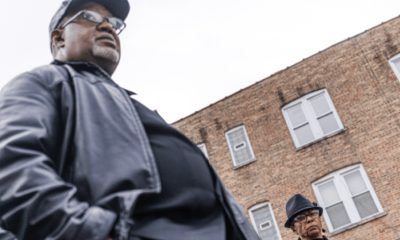Commentary
COMMENTARY: Wisconsin Must Shift Youth Justice Policy to Promote Transformative Change
MILWAUKEE COURIER — As Wisconsin looks to establish a new correctional system for youth, it is incumbent upon us to act with great urgency to respond to the immediate crisis at Lincoln Hills and Copper Lake Schools. We must take deliberate action to promote youth justice system reforms that are most effective, safe, sustainable and support proper care and treatment of our youth.
By Milwaukee Courier
As Wisconsin looks to establish a new correctional system for youth, it is incumbent upon us to act with great urgency to respond to the immediate crisis at Lincoln Hills and Copper Lake Schools. We must take deliberate action to promote youth justice system reforms that are most effective, safe, sustainable and support proper care and treatment of our youth.
While Act 185 has many merits, it doesn’t go far enough. Act 185, which this administration inherited, only marginally improves the status quo while a paradigm shift is needed. Instead of pushing for transformational change, it aims to improve conditions of confinement without reducing the number of youth Wisconsin places in locked custody or the state’s carceral footprint.
In their 2011 publication, No Place for Kids: The Case for Reducing Juvenile Incarceration, the Annie E. Casey Foundation outlined six failings of America’s juvenile corrections facilities. It stated that juvenile corrections facilities are dangerous, ineffective, unnecessary, obsolete, wasteful and inadequate. Given the poor outcomes of Lincoln Hills and Copper Lake, it would be fair to similarly categorize Wisconsin’s juvenile corrections facilities by these pitfalls.

Lincoln Hills School (LHS)
In response to these failings, the Casey Foundation identified six priorities including limiting the eligibility for correctional placements, investing in promising non-residential alternatives, changing the financial incentives, adopting best practice reforms for managing youth offenders, replacing large institutions with small, treatment-oriented facilities, and using data to hold systems accountable. The State of Missouri and Wayne County, Michigan (Detroit) are examples of jurisdictions who used these strategies to eliminate state juvenile correctional facilities and realize remarkable reductions of youth in secure care facilities.
Reports by the Center for Children’s Law and Policy and Columbia University Justice Lab have outlined the successes of the Close to Home initiative implemented in New York City. Since 2011, the model successfully reduced the need for secure care for youth and lowered youth crime rates when compared to the rest of New York State. Other jurisdictions like Philadelphia and Houston are looking to learn from the Close to Home model, as they respond to the failures of their large correctional facilities. The success of models like Close to Home have now prompted over 50 justice system leaders to sign a statement calling for the closure of all youth prisons and placing these youth at home with rigorous community programming, or in small, home-like facilities close to the youth’s families.
If revisions to the DOC 347 were made, Milwaukee County could develop smaller, more home-like secure settings for the majority of youth at Lincoln Hills and Copper Lake and renovate two pods in the Detention Center to serve the youth in need of additional internal structure and security. Only a small number of the youth committed to restrictive custodial care actually require the type of Wisconsin Must Shift Youth Justice Policy to Promote Transformative Change internal security available within a detention center or correctional facility. We believe that such a plan could result in significant savings and reduce the overall institutional footprint, while providing a more trauma-informed and engaging treatment environment for most youth.
Wisconsin has the second highest rate of disparity in confinement between white and black youth in the nation. Black youth are 15 times more likely than white youth to be confined in our state. This is not only true in Milwaukee. It is true across our state. We cannot incarcerate our way out the problems our youth are facing. We must find a better way, and our best opportunity is now.
It is critical to strengthen the network of providers, mentors, coaches, employers, teachers, and advocates who look like and have similar life experiences as our youth. Programs like Running Rebels help young people be successful and lead healthy, prosocial lives. However, it is imperative that we continue to expand the capacity for mentors with lived experience, vocational training, alternative educational, recreational resources and socioeconomic advancement opportunities for underserved youth and families in Milwaukee.
The history of juvenile prison failures spanning decades and across over 30 states, territories, and the District of Columbia, coupled with our own tragic and troubling experiences within Lincoln Hills and Copper Lake Schools more than justify the call for the closing of all youth prisons. To that end, the state should eliminate “Type I” facilities and build regional Secure Residential programs. If we aspire to establish a new, therapeutic treatment culture in our youth justice system, we must understand that words matter. We must do everything within our power to assure that our history of abusive institutions does not repeat itself and we must do so at this critical juncture.
We believe that these proposed changes will position our state to continue to pursue transformative improvements. It is only through this pursuit that we can establish an effective, sustainable and fiscally responsible youth justice system. Wisconsin should not waste this tremendous opportunity to redefine who we are as a state when it comes to youth justice.
This article originally appeared in the Milwaukee Courier.
Activism
Oakland Post: Week of April 17 – 23, 2024
The printed Weekly Edition of the Oakland Post: Week of April 17 – 23, 2024

To enlarge your view of this issue, use the slider, magnifying glass icon or full page icon in the lower right corner of the browser window. ![]()
Commentary
Opinion: Surviving the Earthquake, an Eclipse and “Emil Amok.”
Last Friday, a 4.8 magnitude earthquake shook New York City, reported as the “biggest earthquake with an epicenter in the NYC area since 1884” when a 5.2 quake hit. A bit bigger. The last quake similar to Friday’s was a 4.9 in 1783.Alexander Hamilton felt it — 241 years ago. That’s why New Yorkers were freaking out on Friday. They were in the room where it happens.

By Emil Guillermo
I’m a Northern Californian in New York City for the next few weeks, doing my one-man show, “Emil Amok, Lost NPR Host, Wiley Filipino, Vegan Transdad.”
I must like performing in the wake of Mother Nature.
Last Friday, a 4.8 magnitude earthquake shook New York City, reported as the “biggest earthquake with an epicenter in the NYC area since 1884” when a 5.2 quake hit. A bit bigger. The last quake similar to Friday’s was a 4.9 in 1783.
Alexander Hamilton felt it — 241 years ago.
That’s why New Yorkers were freaking out on Friday. They were in the room where it happens.
And it just doesn’t happen that often.
Beyonce singing country music happens more frequently.
When I felt New York shake last week, it reminded me of a time in a San Francisco TV newsroom when editors fretted about a lack of news an hour before showtime.
Then the office carpeting moved for a good ten seconds, and the news gods gave us our lead story.
On Friday when it happened in NYC, I noticed the lines in the carpeting in my room wiggling. But I thought it was from a raucous hotel worker vacuuming nearby.
I didn’t even think earthquake. In New York?
I just went about my business as if nothing had happened. After living near fault lines all my life, I was taking things for granted.
Considering the age of structures in New York, I should have been even more concerned about falling objects inside (shelves, stuff on walls) and outside buildings (signs, scaffolding), fire hazards from possible gas leaks, and then I should have looked for others on my floor and in the hotel lobby to confirm or aid or tell stories.
Of course, as a Californian who has lived through and covered quakes in the 4 to 6 magnitude range, I tried to calm down any traumatized New Yorker I encountered by taking full responsibility for bringing in the quake from the Bay Area.
I reassured them things would be all right, and then let them know that 4.8s are nothing.
And then I invited them to my consoling post-Earthquake performance of “Emil Amok, Lost NPR Host…”
It was the night of the eclipse.
ECLIPSING THE ECLIPSE
In New York City, the eclipse was about 90 percent visible. Good enough for me. Though a full solar eclipse is a celestial rarity, blockages of any sort aren’t generally celebrated. My one-man play is about growing up with the eclipsed history of American Filipinos and how I struggle to unblock all that.
For example, did you know the first Filipinos actually arrived to what is now California in 1587? That’s 33 years before the Pilgrims arrived in America on the other coast, but few know the Filipino history which has been totally eclipsed.
I was in Battery Park sitting on a bench and there was a sense of community as people all came to look up. A young woman sitting next to me had a filter for a cell phone camera. We began talking and she let me use it. That filter enabled me to take a picture of the main event with my iPhone.
For helping me see, I invited her and her boyfriend to come see my show.
Coincidentally, she was from Plymouth, Massachusetts, near the rock that says the year the Pilgrims landed in 1620.
In my show she learned the truth. The Pilgrims were second.
History unblocked. But it took a solar eclipse.
Next one in 2044? We have a lot more unblocking to do.
If you’re in New York come see my show, Sat. April 13th, 5:20 pm Eastern; Fri. April 19, 8:10 pm Eastern; and Sun. April 21st 5:20 pm Eastern.
You can also livestream the show. Get tickets at www.amok.com/tickets
About the Author
Emil Guillermo is a journalist and commentator. He does a mini-talk show on YouTube.com/@emilamok1. He wishes all his readers a Happy Easter!
Commentary
Commentary: Republican Votes Are Threatening American Democracy
In many ways, it was great that the Iowa Caucuses were on the same day as Martin Luther King Jr. Day. We needed to know the blunt truth. The takeaway message after the Iowa Caucuses where Donald Trump finished more than 30 points in front of Florida Gov. De Santis and former South Carolina Governor Nikki Haley boils down to this: Our democracy is threatened, for real.

By Emil Guillermo
In many ways, it was great that the Iowa Caucuses were on the same day as Martin Luther King Jr. Day.
We needed to know the blunt truth.
The takeaway message after the Iowa Caucuses where Donald Trump finished more than 30 points in front of Florida Gov. De Santis and former South Carolina Governor Nikki Haley boils down to this: Our democracy is threatened, for real.
And to save it will require all hands on deck.
It was strange for Iowans to caucus on MLK day. It had a self-cancelling effect. The day that honored America’s civil rights and anti-discrimination hero was negated by evening.
That’s when one of the least diverse states in the nation let the world know that white Americans absolutely love Donald Trump. No ifs, ands or buts.
No man is above the law? To the majority of his supporters, it seems Trump is.
It’s an anti-democracy loyalty that has spread like a political virus.
No matter what he does, Trump’s their guy. Trump received 51% of caucus-goers votes to beat Florida Gov. Ron DeSantis, who garnered 21.2%, and former South Carolina Gov. Nikki Haley, who got 19.1%.
The Asian flash in the pan Vivek Ramaswamy finished way behind and dropped out. Perhaps to get in the VP line. Don’t count on it.
According to CNN’s entrance polls, when caucus-goers were asked if they were a part of the “MAGA movement,” nearly half — 46% — said yes. More revealing: “Do you think Biden legitimately won in 2020?”
Only 29% said “yes.”
That means an overwhelming 66% said “no,” thus showing the deep roots in Iowa of the “Big Lie,” the belief in a falsehood that Trump was a victim of election theft.
Even more revealing and posing a direct threat to our democracy was the question of whether Trump was fit for the presidency, even if convicted of a crime.
Sixty-five percent said “yes.”
Who says that about anyone of color indicted on 91 criminal felony counts?
Would a BIPOC executive found liable for business fraud in civil court be given a pass?
How about a BIPOC person found liable for sexual assault?
Iowans have debased the phrase, “no man is above the law.” It’s a mindset that would vote in an American dictatorship.
Compare Iowa with voters in Asia last weekend. Taiwan rejected threats from authoritarian Beijing and elected pro-democracy Taiwanese vice president Lai Ching-te as its new president.
Meanwhile, in our country, which supposedly knows a thing or two about democracy, the Iowa caucuses show how Americans feel about authoritarianism.
Some Americans actually like it even more than the Constitution allows.
About the Author
Emil Guillermo is a journalist and commentator. He does a mini-talk show on YouTube.com/@emilamok1.
-

 Activism4 weeks ago
Activism4 weeks agoOakland Post: Week of March 27 – April 2, 2024
-

 #NNPA BlackPress4 weeks ago
#NNPA BlackPress4 weeks agoCOMMENTARY: D.C. Crime Bill Fails to Address Root Causes of Violence and Incarceration
-

 #NNPA BlackPress4 weeks ago
#NNPA BlackPress4 weeks agoMayor, City Council President React to May 31 Closing of Birmingham-Southern College
-

 #NNPA BlackPress4 weeks ago
#NNPA BlackPress4 weeks agoBeloved Actor and Activist Louis Cameron Gossett Jr. Dies at 87
-

 Community1 week ago
Community1 week agoFinancial Assistance Bill for Descendants of Enslaved Persons to Help Them Purchase, Own, or Maintain a Home
-

 Activism3 weeks ago
Activism3 weeks agoOakland Post: Week of April 3 – 6, 2024
-

 Business1 week ago
Business1 week agoV.P. Kamala Harris: Americans With Criminal Records Will Soon Be Eligible for SBA Loans
-

 Activism2 weeks ago
Activism2 weeks agoOakland Post: Week of April 10 – 16, 2024





















































